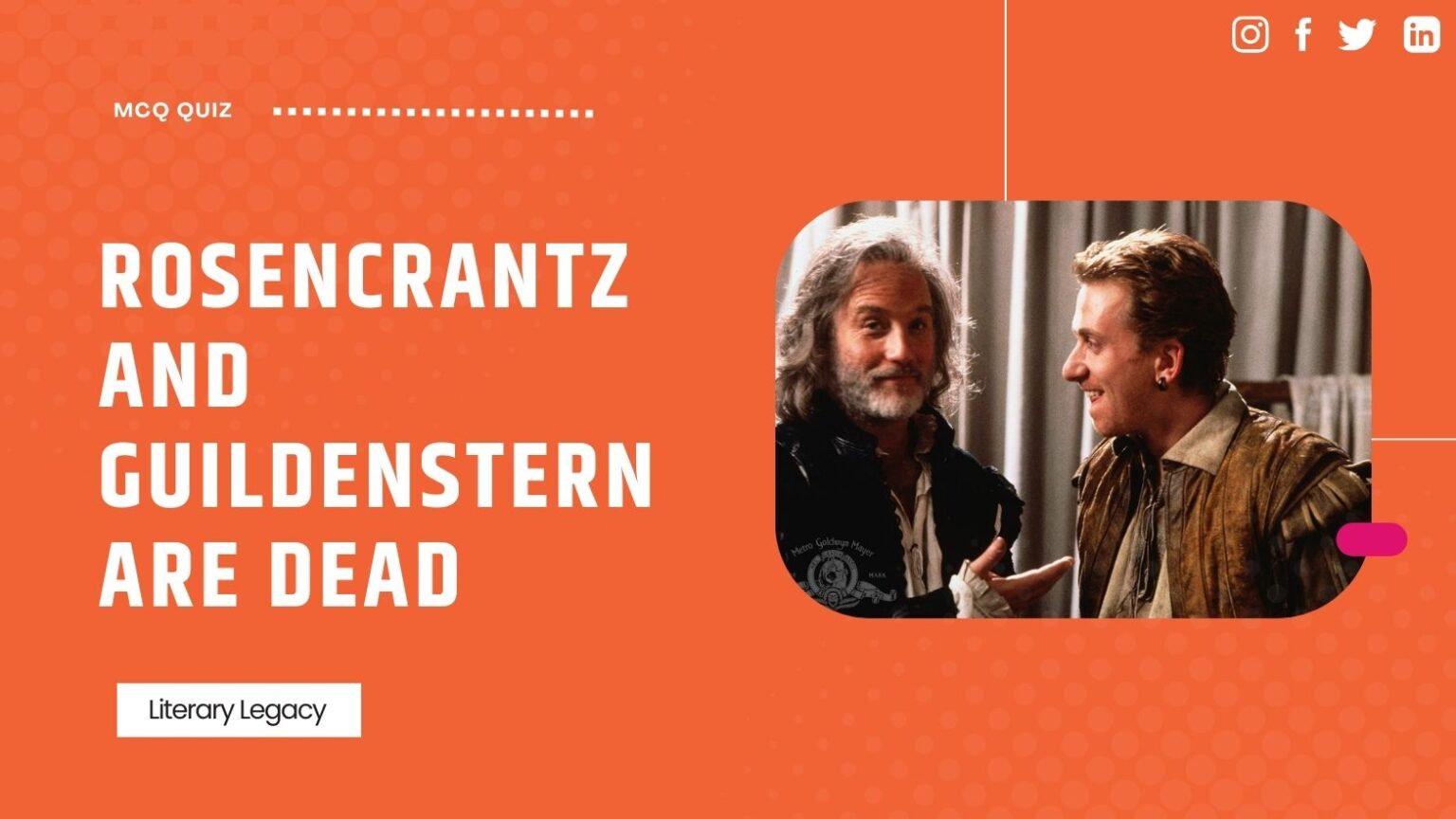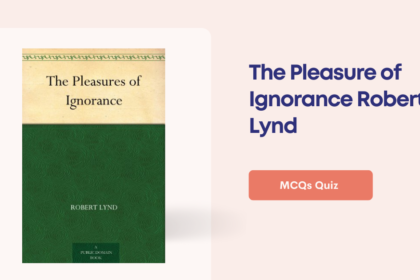1. What prompts Rosencrantz to express that their situation could have been worse?
A) The Player’s arrival
B) Hearing the Tragedians’ music
C) The chaos caused by pirates
D) Finding Hamlet’s behavior strange
Answer: (B)
Hearing the Tragedians’ music
Rosencrantz reflects on their situation after hearing the music, suggesting a sense of optimism despite the turmoil.
2. What does the Player reveal about why they had to escape?
A) Claudius was angered by their performance
B) Their play was poorly received
C) They were captured by pirates
D) They lost a bet
Answer: (A)
Claudius was angered by their performance
The Player mentions that Claudius was furious about their play, which led them to disguise themselves and escape.
3. How do Rosencrantz and Guildenstern feel about their freedom after speaking with the Player?
A) They feel completely liberated
B) They acknowledge it is limited
C) They are indifferent to their freedom
D) They question its existence
Answer: (B)
They acknowledge it is limited
Both characters recognize that their sense of freedom is very constrained despite the notion that they are free.
4. What key action does Hamlet take towards Rosencrantz and Guildenstern?
A) He insults their performance
B) He embraces them
C) He ignores them completely
D) He spits in their direction
Answer: (D)
He spits in their direction
Hamlet’s spitting at them suggests a high level of contempt or disdain for Rosencrantz and Guildenstern.
5. What causes Guildenstern to lash out at Rosencrantz?
A) The Player’s indifferent attitude towards death
B) The unexpected appearance of Hamlet
C) The realization of their fate in the letter
D) Frustration over their chaotic situation
Answer: (D)
Frustration over their chaotic situation
Guildenstern’s anguish over the pointlessness of their situation leads him to snap at Rosencrantz.
6. What significant transition occurs when the lights come back on?
A) Hamlet emerges from the shadows
B) Only two barrels remain
C) Rosencrantz and Guildenstern are captured
D) The Tragedians vanish from the stage
Answer: (B)
Only two barrels remain
The reduction to two barrels signifies a critical change in their circumstances, particularly the disappearance of Hamlet.
7. What unexpected content does Guildenstern find in the letter?
A) A plea for their help
B) Orders for Hamlet’s return
C) A death sentence for both of them
D) An invitation to a royal banquet
Answer: (C)
A death sentence for both of them
The letter’s directive for their deaths creates a turning point in the narrative, emphasizing their dire situation.
8. What philosophical concept does the Player discuss with Guildenstern?
A) The importance of narrative structure
B) The similarity between real and theatrical death
C) The illusion of freedom
D) The nature of friendship
Answer: (B)
The similarity between real and theatrical death
The Player suggests that death in performances is as significant as real death, prompting a debate with Guildenstern.
9. Which emotion predominantly influences Guildenstern’s reaction throughout the passage?
A) Curiosity
B) Joy
C) Conflict
D) Despair
Answer: (D)
Despair
Guildenstern’s despair showcases his internal struggle with their precarious fate and the absurdity of their existence.
10. What action leads to the chaotic scene following Hamlet’s interaction?
A) The pirates attack the ship
B) Hamlet leaves the stage
C) The Player begins to sing again
D) Rosencrantz and Guildenstern begin a fight
Answer: (A)
The pirates attack the ship
The attack by pirates escalates the tension and chaos of the scene, causing chaos on stage.
11. What is the reaction of the Tragedians to the Player’s death after Guildenstern stabs him?
A) They express shock and fear.
B) They ignore the event completely.
C) They criticize Guildenstern’s actions.
D) They applaud the performance.
Answer: (D)
They applaud the performance.
The Tragedians applaud, showing their detachment from the gravity of the situation.
12. What realization does Rosencrantz come to at the end regarding their situation?
A) They are destined to die and cannot escape.
B) They can change their fates.
C) Their actions were the cause of their demise.
D) They did nothing wrong.
Answer: (A)
They are destined to die and cannot escape.
Rosencrantz acknowledges that they have done nothing wrong but also expresses despair over their fate.
13. How does Guildenstern feel about his identity towards the end of the play?
A) He forgets his name completely.
B) He confidently asserts he is Guildenstern.
C) He wishes to be someone else entirely.
D) He is unsure whether he is Guildenstern or Rosencrantz.
Answer: (D)
He is unsure whether he is Guildenstern or Rosencrantz.
Guildenstern cries out for his friend but is unable to remember if he is Guildenstern or Rosencrantz.
14. What does the Player claim about deaths that people believe in?
A) Only stage deaths are truly believed.
B) People are indifferent to all types of deaths.
C) All deaths are equally believed.
D) Real deaths are more compelling than performances.
Answer: (A)
Only stage deaths are truly believed.
The Player suggests that only deaths people witness on stage are believed.
15. What is the ultimate fate of Rosencrantz and Guildenstern as stated by the English ambassador?
A) They successfully escape their fate.
B) They are executed as per Claudius’s orders.
C) They are pardoned by Claudius.
D) They decide to hide on the ship forever.
Answer: (B)
They are executed as per Claudius’s orders.
The English ambassador announces that they have been executed as ordered by Claudius.
16. In what manner do Guildenstern and Rosencrantz become more sympathetic characters throughout the play?
A) They show deep understanding and empathy towards others.
B) They successfully accomplish their goals.
C) They become heroic figures through their actions.
D) Their helplessness and confusion elicit sympathy.
Answer: (D)
Their helplessness and confusion elicit sympathy.
As their plight becomes clearer, readers recognize their helplessness, leading to increased sympathy.
17. What does Guildenstern begin to question about their past actions?
A) Why they chose to become actors.
B) If they were wrong to help Hamlet.
C) Whether they could have prevented their fate.
D) If they should have sided with Claudius.
Answer: (C)
Whether they could have prevented their fate.
Guildenstern reflects on their actions, believing they had an opportunity to prevent their tragic fate.
18. What common theme is explored through the characters of Rosencrantz and Guildenstern?
A) The inevitability of death.
B) The joys of friendship.
C) The certainty of success in life.
D) The futility of seeking revenge.
Answer: (A)
The inevitability of death.
The play highlights the characters’ struggles with the inevitability of their deaths.
19. How does the light change at the moment of the Player’s death?
A) The lights extinguish completely.
B) The lights flicker chaotically.
C) The lights dim as the Player dies.
D) The lights go brighter to signify hope.
Answer: (C)
The lights dim as the Player dies.
As the Player mimes his death, the lights dim, signifying the gravity of the moment.
20. What does the character of Horatio express when the English ambassador announces the executions?
A) Joy at the news.
B) Disbelief that Claudius ordered the executions.
C) Indifference to the events.
D) Fear of impending doom.
Answer: (B)
Disbelief that Claudius ordered the executions.
Horatio laments that Claudius did not actually order the deaths of Rosencrantz and Guildenstern.
21. What motivates Rosencrantz and Guildenstern to investigate Hamlet’s behavior?
A) They aim to win favor with the queen.
B) They are seeking revenge on Hamlet.
C) They want to prove their loyalty to Claudius.
D) They wish to understand the cause of Hamlet’s strange behavior.
Answer: (D)
They wish to understand the cause of Hamlet’s strange behavior.
Rosencrantz and Guildenstern are childhood friends of Hamlet and are concerned about his well-being.
22. How is Guildenstern’s personality best described?
A) He is contemplative and seeks to understand life.
B) He is overtly ambitious and scheming.
C) He is carefree and indifferent to his fate.
D) He is excessively confident and arrogant.
Answer: (A)
He is contemplative and seeks to understand life.
Guildenstern is a meditative man, reflecting on his purpose in the world.
23. What role does The Player play within the story?
A) He is a nobleman who secretly supports Hamlet.
B) He is Hamlet’s closest ally.
C) He leads a group of traveling male actors.
D) He acts as a spy for Claudius.
Answer: (C)
He leads a group of traveling male actors.
The Player is the leader of the traveling actors known as the Tragedians.
24. Which character is known for being shifty and willing to spy on Hamlet?
A) Laertes
B) Polonius
C) Gertrude
D) Claudis
Answer: (B)
Polonius
Polonius is an adviser who engages in espionage to learn more about Hamlet.
25. What causes Hamlet’s personal crisis in the play?
A) The death of his father and his uncle’s actions.
B) His strained relationship with Ophelia.
C) His rivalry with Laertes.
D) His mother’s quick remarriage.
Answer: (A)
The death of his father and his uncle’s actions.
Hamlet is deeply affected by his father’s death and his uncle marrying his mother.
26. What is the main characteristic of the Tragedians’ performances?
A) They are known for their realistic portrayals.
B) They avoid any form of sexual entertainment.
C) They specialize in melodrama and sensationalism.
D) They focus exclusively on historical narratives.
Answer: (C)
They specialize in melodrama and sensationalism.
The Tragedians are characterized by their sensational and melodramatic acting style.
27. Which of the following statements is true about Gertrude’s character?
A) She is unaware of Hamlet’s concerns.
B) She married Claudius without considering the implications.
C) She neglects Hamlet’s well-being entirely.
D) She is an antagonistic figure towards Rosencrantz.
Answer: (B)
She married Claudius without considering the implications.
Gertrude marries Claudius shortly after her husband’s death, causing confusion for Hamlet.
28. How does the character of Claudius utilize Rosencrantz and Guildenstern?
A) He exploits their friendship to spy on Hamlet.
B) He trains them as actors for the Tragedians.
C) He offers them positions in his court.
D) He assigns them to protect Hamlet from danger.
Answer: (A)
He exploits their friendship to spy on Hamlet.
Claudius seeks to learn about Hamlet’s feelings regarding his marriage by using his friends.
29. What emotional state does Ophelia experience throughout the play?
A) She is predominantly joyful and hopeful.
B) She is indifferent to Hamlet’s actions.
C) She is filled with shock and anguish.
D) She remains focused on political ambitions.
Answer: (C)
She is filled with shock and anguish.
Ophelia is heavily affected by Hamlet’s bizarre conduct, resulting in her emotional turmoil.
30. Which character seeks to understand their own purpose in the world, alongside Hamlet’s condition?
A) Claudius
B) Guildenstern
C) Rosencrantz
D) Laertes
Answer: (B)
Guildenstern
Guildenstern reflects on his existence while trying to discern Hamlet’s distress.
31. What is the primary purpose of Hamlet requesting the performance of The Murder of Gonzago?
A) To confuse Rosencrantz and Guildenstern
B) To teach a lesson about revenge
C) To entertain the court with a new play
D) To expose Claudius’ guilt regarding his father’s murder
Answer: (D)
To expose Claudius’ guilt regarding his father’s murder
Hamlet’s intention is to reveal Claudius’ guilt, paralleling the events depicted in his father’s murder.
32. How does Stoppard create dramatic irony in the play?
A) By having the characters know more than the audience
B) By making the audience unaware of the play within a play
C) By allowing the protagonists to predict their fates accurately
D) By revealing the characters’ motives to the audience while keeping the protagonists in the dark
Answer: (D)
By revealing the characters’ motives to the audience while keeping the protagonists in the dark
The audience is aware of Hamlet’s motives while Rosencrantz and Guildenstern remain clueless, creating a tension filled with irony.
33. What theme does Stoppard emphasize by creating a distance between the audience and the characters?
A) The ideological relationship between theatrical performances and their audiences
B) The necessity of resolving conflicts on stage
C) The importance of personal connection in drama
D) The emotional struggles of the protagonists
Answer: (A)
The ideological relationship between theatrical performances and their audiences
Stoppard encourages the audience to contemplate their role and relationship with the performance, instead of simply empathizing with the characters.
34. What detail confuses Rosencrantz and Guildenstern during the rehearsal of The Murder of Gonzago?
A) The actors forget their lines
B) The fact that the play is too long
C) The identical costumes worn by characters and themselves
D) The absence of their own characters in the play
Answer: (C)
The identical costumes worn by characters and themselves
Rosencrantz and Guildenstern are baffled by seeing characters dressed like them, without realizing it foreshadows their own deaths.
35. How does Stoppard depict the relationship between the audience and the action of the play?
A) As a complicated interaction filled with confusion
B) As a direct emotional engagement with the characters
C) As one of passive observation without thought
D) As a purely intellectual analysis devoid of feelings
Answer: (D)
As a purely intellectual analysis devoid of feelings
By removing emotional ties to the characters, the audience can engage with the play’s ideas on a more intellectual level.
36. What does the Player suggest about audience belief during the rehearsal?
A) Audiences only see what they expect to see
B) Audiences can interpret any performance in multiple ways
C) Audiences should be more critical of the play
D) Audiences are fooled by tragic performances
Answer: (A)
Audiences only see what they expect to see
The Player’s claim emphasizes that audience expectations shape their perception of the play’s reality.
37. What is one result of having the audience aware of the outcomes of the play?
A) It creates a sense of detachment from the characters
B) It makes the play harder to follow
C) It leads to misunderstandings of the plot
D) It builds suspense and encourages closer emotional ties
Answer: (A)
It creates a sense of detachment from the characters
The audience’s awareness of impending events creates a detachment, allowing for an intellectual examination of themes.
38. What critical perspective does Stoppard ultimately encourage in his audience?
A) To empathize deeply with every character
B) To think critically about the nature of theatrical performance
C) To focus solely on the plot and character development
D) To ignore the play’s themes for personal enjoyment
Answer: (B)
To think critically about the nature of theatrical performance
By emphasizing the relationship between audience and performance, Stoppard prompts critical thinking about theater.
39. How is the structure of the play within a play significant to Stoppard’s themes?
A) It highlights the absurdity of the characters’ situation
B) It allows for a straightforward narrative
C) It simplifies the relationship between the audience and characters
D) It creates layers of meaning regarding performance and perception
Answer: (D)
It creates layers of meaning regarding performance and perception
The dual-layered structure emphasizes the complexity of observing performances and the expectations associated with them.
40. What does the experience of viewing Rosencrantz and Guildenstern’s confusion during the rehearsal illustrate?
A) The disconnect between fate and personal awareness
B) The humor in dramatic irony
C) The folly of the characters’ decisions
D) The effectiveness of comedy in the play
Answer: (A)
The disconnect between fate and personal awareness
Their inability to recognize the prediction of their own deaths highlights a theme of fate versus awareness.



